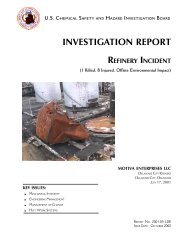CTA Report, Draft 1, ISP Review - US Chemical Safety and Hazard ...
CTA Report, Draft 1, ISP Review - US Chemical Safety and Hazard ...
CTA Report, Draft 1, ISP Review - US Chemical Safety and Hazard ...
You also want an ePaper? Increase the reach of your titles
YUMPU automatically turns print PDFs into web optimized ePapers that Google loves.
elements—dust suspension <strong>and</strong> confinement. 14 Suspended dust burns more rapidly, <strong>and</strong> confinement<br />
allows for pressure buildup.<br />
Fuel, ignition, oxygen, suspension, <strong>and</strong> confinement form the five sides of the dust explosion pentagon<br />
(Figure 10). Removing either the suspension or confinement elements prevents an explosion, though a<br />
fire may still occur.<br />
6.3 Significance of Particle Size<br />
Figure 10. Dust explosion pentagon.<br />
The ease of ignition <strong>and</strong> severity of combustible dust explosions are primarily influenced by particle size<br />
or specific surface area. 15 Finely divided particles have a large surface area, which allows them to rapidly<br />
react with oxygen when dispersed in air <strong>and</strong> ignited. The larger the surface area, the faster the reaction,<br />
<strong>and</strong> the larger the explosion.<br />
14<br />
Confinement keeps dust particles in proximity after suspension—which allows for sufficiently rapid heat transfer<br />
to allow continued propagation. Without confinement, a propagating explosion is not possible, though a large <strong>and</strong><br />
very dangerous fireball may occur.<br />
15<br />
Specific surface area is the total surface area per unit volume or unit mass of dust.<br />
46









